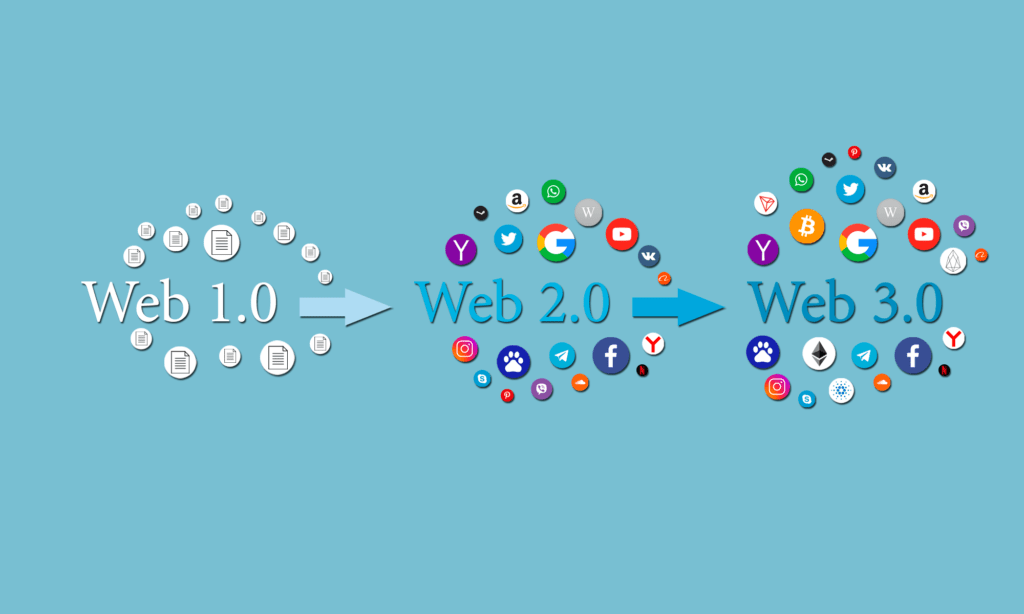The internet is a remarkable technology that has delivered everything it promised in the previous years. It has revolutionized various aspects of our lives, including education, personal communication, urban planning, and business operations. What’s even more exciting is that the internet is still in its early stages of development.
We are on the verge of a technological revolution that will involve a proliferation of artificial intelligence, machine learning capabilities, natural language processing, and advances in blockchain development.
Simultaneously, the conversion to Web 3.0 causes enormous social, economic, and business changes. Web 3.0 symbolizes the third generation of online technology, with the potential to have a long-term influence. Examples of this shift include open-source software, the Internet of Things, and the availability of open-access scholarly outputs.
So, how will Web 3.0 change internet usage, and how will it impact businesses? To dive into these questions, let’s explore the evolution of the Web, beginning with the readable Web 1.0, progressing to the interactive and social Web 2.0, and eventually arriving at the user-centered Web 3.0.
Web 1.0, Web 2.0, Web 3.0

Web 1.0, introduced by the British physicist and computer scientist Tim Berners-Lee in 1989, marked the initial web implementation of the World Wide Web. The worldwide project of information connection networks initially relied on hyperlinks to connect information, allowing users to navigate non-linearly movement based on their preferences and needs.
During this first stage, “readable,” the web resembled an online library or news feed, offering limited interaction between users and websites. Then came Web 2.0 around 2005, which facilitated the creation of global communities with shared interests and introduced more significant user interaction with other users. This era, often referred to as the Social Web or Web 2.0, a “writable” platform, was characterized by social media dominance, real-time information sharing, and the emergence of self-publishing tools like WordPress and blogs.
However, as Web 2.0 progressed, it revealed the dominance of large corporations that recognized the business potential in collecting and processing personal user data. In response, the latest technological evolution stage aims to create a transparent, user-centered, secure, and decentralized web. This new project addresses the need for a more equitable and privacy-focused internet experience.
User-Centric Model of Web 3.0
Web 3.0, also known as the “semantic web technologies,” “3D web”, or “the spatial web,” represents a fragmentary description of a still-evolving successor to Web 2.0. Regardless of the numerous names, the primary goal of the next-generation Web 3.0 remains the same: restoring the web to its users.
One of the fundamental elements of Web 3.0 is the use of distributed ledger technology, with blockchain being a prime example. Blockchain technology keeps a decentralized, secure, anonymous, and transparent record of all network activities, protecting data integrity and privacy. Web 3.0 encourages open ecosystems by utilizing blockchain, eliminating the need for central moderation and reducing dependency on intermediaries. Instead, the goal is to increase the value of services or products. Blockchain’s adaptability makes it suitable for use in various businesses involving data transfers.
Three Universal Business Values in The Web 3.0 Era

In the era of Web 3.0, characterized by the emergence of the semantic web and its intricate phenomenon bordering on science and ethics, it’s imperative to delve into the fundamental business values that will become key in the era of Web 3.0:
- Transparency
Foster transparent relationships between brands and clients, prioritizing user privacy and granting users control over their data processing and access.
- Innovation
Embrace rapid responsiveness to user needs by leveraging emerging technologies and tapping into the convergence of the digital and physical worlds within the metaverse.
- User-centricity
Ensure that your product delivers genuine value to users while making a positive societal impact. Prioritize a user-oriented approach, foster open collaboration, and engage with the community.
Exciting Web 3.0 Features …
- The Semantic Web incorporates language-based search capabilities.
- Users are empowered with programming capabilities, shifting power away from centralized data centers.
- Information is decentralized, making it accessible to everyone.
- Data is generated by various computing resources, including desktop computers, mobile phones, appliances, automobiles, and sensors.
- Web 3.0 is built on blockchain technology, which is irrefutable, unbreakable technology or “trustless.”.
- It is a permissionless system where users own their data and can search, publish, and share information without relying on intermediaries like Google or Bing.
- Transactions are recorded on a distributed ledger.
- Smart contracts eliminate the need for centralized organizations like banks to maintain data or ensure data integrity.
- Blockchain enables the creation and protection of digital goods and Non-Fungible Tokens (NFTs) to safeguard intellectual property.
Web 3.0: The Impact on Business
- Enhances both customer and employee experiences.
- Mitigates business risks through enhanced efficiencies and streamlined processes.
- Bolsters data security and encryption, reducing vulnerability.
- Promotes universal accessibility to content, breaking down data monopolies.
- Empowers users with complete control over their data.
- Allows users to select which information to share and which to withhold.
- Fosters a creator economy, ensuring creators receive fair value for their work.
- Facilitates effortless access to a wide array of data, fostering connections between services.
- Enables easy and immutable tracking of historical information.
- Promotes transparency in all processes and actions.
- Accelerates transaction processing and verification.
- Enhances cost efficiency throughout the organization.
- Simplifies problem-solving and handling of complex, knowledge-intensive tasks.
What Does This Mean for Businesses?
Personalization:
Web 3.0 revolves around personalization and the Semantic Web, incorporating real-time data from various platforms. Semantic technology creates a meaningful framework for human interaction and interests online. This format enables better online matchmaking, content distribution, and improved control over online privacy through smarter distribution.
In a Web 3.0 environment, relevant search, location-based services, mobile integration, and rich social interaction are seamlessly integrated into a unified online experience. This significantly enhances the user experience and provides marketers with opportunities for targeted advertising and promotions, provided they understand the suitable business model.
Mobile Integration:
What began as a trend has now become a standard practice. Embracing Web 3.0 requires businesses to offer a mobile experience to end-users, facilitating more effective communication and easy access to the target audience. Implementing a Web 3.0 strategy in the long run leads to improved intelligence and customer engagement. Mobile user experience capabilities in the Web 3.0 era open up new avenues for innovation in advertising and promotion.
Technology services can now leverage social graph data from platforms like Facebook and real-time/real-world information. This includes data such as the user’s current location, weather conditions, traffic updates, nearby local businesses, and even the user’s past visits to specific stores or locations. This wealth of information creates new opportunities for commerce and advertising.
Utilizing Big Data:
Companies and enterprises rely increasingly on big data in today’s business landscape. A CRM tool must have a comprehensive record of past, current, and potential customer interactions. Neglecting to leverage big data means missing out on valuable buying opportunities.
Google Search:
Google has introduced Google Commerce Search 3.0, which harnesses the power, speed, and flexibility of Google’s search technology to enhance sales and usability in online stores through customized search results. The focus is on delivering accurate and intelligent data across different channels.
Intelligent Marketing:
With Web 3.0, businesses can implement more efficient strategies through integrated intelligent data. Content will be presented to users in the most relevant manner possible.
For instance, Demandbase is a Real-time Targeting and Personalization platform for B2B businesses. It identifies the companies that visit a website and makes this insight actionable in existing marketing and sales programs. Real-time identification allows for targeted decision-making and personalized content or web experiences based on otherwise unavailable attributes of the visitor, such as specific company details, industry, or CRM-based information.
Social Media:
Web 3.0 will grant marketers access to their audience data on social media platforms like Facebook, Twitter, and Instagram while giving users more control over who can access that information. This means marketers won’t rely on third-party intermediaries for data access and can keep customer data more secure.
The Bottom Line: Web 3.0 Creates Business Opportunities
Although Web 3.0 may seem significantly different from Web 2.0, we are already familiar with many aspects of Web 3.0, thanks to the increased usage of AI and blockchain technology facilitated by intuitive apps, virtual assistants, smart products, chatbots, and more.
Incorporating Web 3.0 into your business provides the freedom of information and direct control over data and intellectual property without intermediaries, thereby creating business opportunities. It leads to improved personal and business efficiencies, enhanced customer and employee experiences, streamlined and accurate processes, strengthened security, and enhanced collaboration, all contributing to increased profitability.
FAQ’s – Frequently Asked Questions
1. What distinguishes Web3 from previous phases of internet evolution?
Web3 is a departure from earlier internet eras that were centralized, and it prefers privacy and security-focused decentralization. Unlike those that came before them, Web3 keeps users’ private information in their hands, which enhances trustworthiness and visibility in the cyber world.
2. What benefits does Web3 provide enterprises in terms of security?
Web3 transforms security methods by decentralizing data storage and transactions, hence reducing risks associated with centralized systems. This decentralized strategy improves data security while reducing exposure to cyber attacks, resulting in a durable and secure digital environment suitable for corporate operations.
3. How does Web3’s financial decentralization benefit businesses?
Web3’s focus on financial decentralization enables firms to remove intermediaries and lower transaction costs. Businesses may use blockchain technology to improve financial procedures, reduce risks, and increase financial autonomy. This shift towards decentralized finance fosters innovation, efficiency, and inclusivity within the business landscape.
4. What implications does Web3 hold for businesses?
Web 3.0 represents the next evolutionary leap in internet technology. It pledges a decentralized infrastructure, bolstering privacy and security for all users.
5. What opportunities does Web3 present for busineses?
Web 3.0 opens doors to various business opportunities, including:
1. Enhanced Security
2. Elimination of Middlemen
3. Financial Decentralization

